
The Best Nootropics for Focus, Memory, and Performance
Boost focus and brainpower naturally. We review the top nootropics that support performance, memory, and mental clarity.

For years, we’ve all heard the same message: sunlight is the enemy, and sunscreen is our shield. From dermatologists to beauty magazines, the advice rarely changes — wear SPF every day, even when you’re indoors. For many, it’s become one of those “rules” we hardly question anymore.
Yet behind this well-meaning advice lies a contradiction we rarely question. Skin cancer rates have continued to rise despite record levels of sunscreen use. Meanwhile, vitamin D deficiency — once rare — is now common across much of the developed world. By relying on sunscreen, we are inadvertently blocking the very wavelength of light responsible for one of the most vital hormones in human biology, all while smearing our largest organ with synthetic chemicals designed to penetrate it.
The idea that sunscreen is purely beneficial has gone largely unchallenged. But recent research tells a more complicated story. Studies now show that certain chemical filters used in sunscreens are absorbed into the bloodstream, cross the placenta, and have been detected in breast milk and the environment — from rivers to coral reefs. Others raise questions about hormonal disruption, oxidative stress, and ecological persistence.
This doesn’t mean sunlight should be ignored or that all sunscreens are harmful. But it does mean that the conversation has been oversimplified. When the same corporations selling SPF also fund the research reassuring us of its safety, public trust becomes a matter not of science, but of marketing.
In this article, we’ll unpack what the evidence really says — about how sunscreens work, what their ingredients do inside the body and the environment, how they may interfere with vitamin D, and why “protecting yourself from the sun” might not be as straightforward as it sounds.
Because sunlight is not the enemy — misinformation is.
To understand the sunscreen debate, it helps to know what these products are actually designed to do — and what they’re not.
Sunlight that reaches Earth contains three types of ultraviolet radiation: UVA, UVB, and UVC. The ozone layer blocks all UVC and most UVB, but UVA and some UVB still reach the skin. Both can damage DNA and accelerate aging, yet they act in very different ways.
UVB (290–320 nm) is the higher-energy form of sunlight that affects the skin’s surface — it’s what causes sunburn and direct DNA damage, but it also triggers the vital conversion of cholesterol in the skin into vitamin D₃, supporting bone, immune, and metabolic health.
UVA (320–400 nm) penetrates much deeper, generating oxidative stress that breaks down collagen, accelerates wrinkles and pigmentation, and can indirectly damage DNA — yet it also plays a minor role in tanning and nitric oxide release, which may benefit mood and circulation.
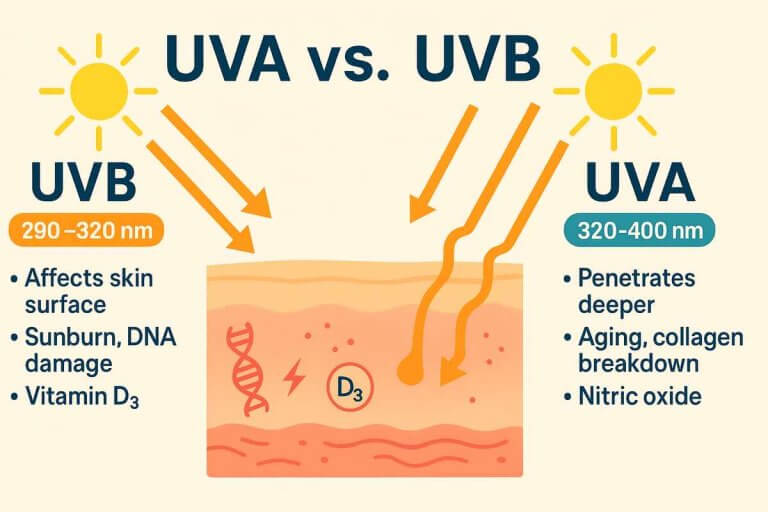
As with most things in life, it’s all about moderation. Sunscreens are designed to interrupt these processes in one of two main ways:
The strength of UVB protection is expressed as the SPF (Sun Protection Factor). It measures how much longer it takes for skin to redden with sunscreen versus without. For example, SPF 15 blocks about 93 % of UVB rays, SPF 30 about 97 %, and SPF 50 about 98 %. The scale isn’t linear — after SPF 30, each step offers only a marginal increase in UVB protection.
However, SPF says nothing about UVA, the form most responsible for long-term aging and deeper DNA damage. That’s why “broad-spectrum” formulas are encouraged — yet even those vary widely in how much UVA they truly block.
The problem with these numbers is that they assume perfect, laboratory-style use — two milligrams per square centimeter of skin, reapplied every two hours. In real life, most people apply less than half that amount and rarely reapply, which means their effective protection is far lower than the label suggests.
So while sunscreens are technically effective barriers under ideal conditions, their performance in the real world — and their chemical footprint inside the body — tell a much messier story.
The safety debate around sunscreen isn’t about whether it blocks UV light — it’s about what happens once those chemicals are absorbed. And the truth is, most modern sunscreens rely on synthetic compounds designed not just to sit on the skin, but to blend invisibly into it.
These filters fall into two categories: organic (chemical) and inorganic (mineral). Chemical filters dominate the market because they feel lighter, don’t leave a white film, and can be mixed easily into lotions or makeup. But many of them are biologically active — capable of crossing the skin barrier, binding to hormone receptors, and persisting in the environment.
Here’s what the research says about some of the most common ones:
One of the most widely used UV filters, oxybenzone absorbs both UVA and UVB radiation — but it’s also among the most controversial.
Despite these findings, oxybenzone remains FDA-approved, largely on the basis that blood concentrations, though measurable, are “unlikely to cause harm.” That conclusion is debated, especially given a lack of long-term human data.
Common in moisturizers and daily SPFs, octinoxate absorbs UVB rays but has shown estrogenic and thyroid-altering effects in animal models.
Banned in some regions (such as Hawaii and Palau) for its toxic effects on coral reefs.
The main UVA absorber in many broad-spectrum formulas. It’s relatively effective — but chemically unstable, degrading by up to 50% within an hour of UV exposure unless stabilized with other filters like octocrylene or oxybenzone. The result is a chemical cocktail of reactive breakdown products whose safety has barely been studied.
One of the more stable chemical filters, often used to “anchor” others. It’s generally considered lower-risk for irritation but can convert to benzophenone over time — the same compound that regulators have flagged for potential toxicity.
Used more commonly in Europe, these camphor derivatives have been shown in animal studies to alter sex hormone signaling and delay puberty in males. Both are persistent environmental contaminants.
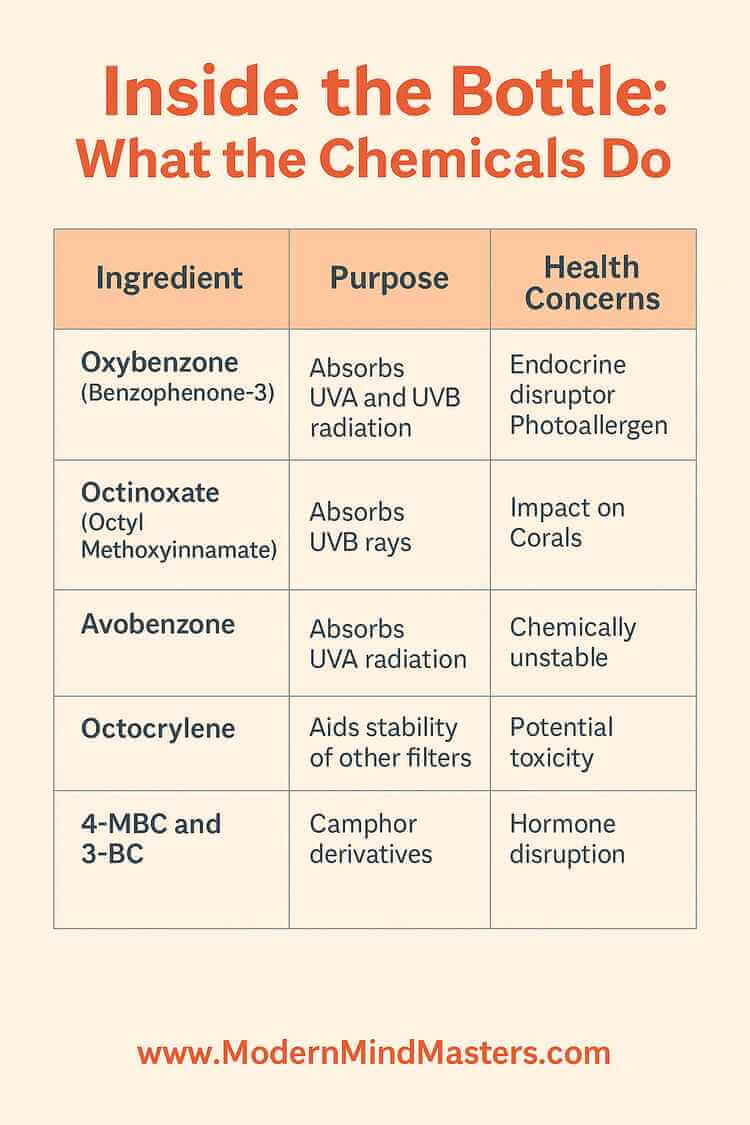
Chemical sunscreens work by design: their small, lipid-soluble molecules slip through skin oils and interact at a cellular level. This efficiency, ironically, is what raises concern. Studies confirm systemic absorption after normal topical use, often within hours. Blood concentrations in human trials have exceeded FDA thresholds that normally trigger further toxicology testing — yet the products remain on shelves, pending “more data.”
Industry-funded reviews tend to downplay this, often describing the risk as “negligible.” But independent toxicology research paints a more cautious picture, linking these same compounds to oxidative stress, mitochondrial dysfunction, neurotoxicity, and hormonal interference (at least in vitro and in animal models).
By contrast, mineral filters like zinc oxide and titanium dioxide tend to stay on the skin’s surface, acting as reflective barriers. Non-nano forms show minimal penetration and low irritation. However, their nano versions, favored for cosmetic appeal, introduce new questions about reactivity and inhalation safety, especially in sprays and powders.
Every time we shower, swim, or wash our hands, the sunscreen on our skin doesn’t just disappear — it almost always enters the water system. And unlike organic matter, many of these synthetic UV filters don’t biodegrade. They persist, travel, and accumulate.
Over the past two decades, scientists have detected chemical sunscreen ingredients in rivers, lakes, oceans, and even drinking water. Oxybenzone, octinoxate, and avobenzone are now among the most common UV filters found in wastewater and surface water worldwide. Traces of these same compounds have been found in fish, shellfish, seabirds, and coral reefs, showing that what begins on human skin doesn’t stay there.
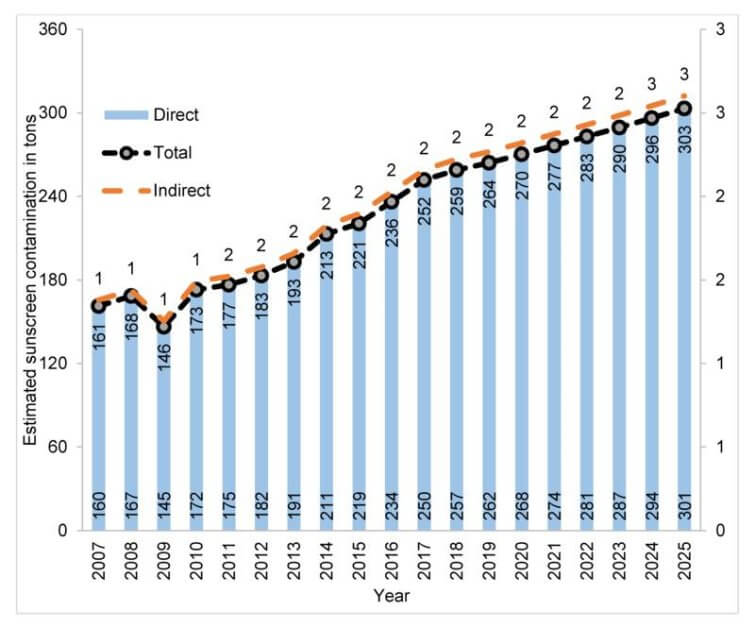
Now, you might not think this is a big deal — or you may not feel especially concerned about the environment compared to your own health — but if you drink tap water in any form, this does affect you. These chemicals don’t just circulate through ecosystems; they return to the very water we filter, drink, and cook with. The boundary between environmental health and personal health doesn’t really exist.
A 2024 review published in Clinical and Experimental Dermatology reported that organic UV filters are entering the food chain, with evidence of bioaccumulation and endocrine disruption in aquatic species.
One compound in particular, oxybenzone, has been found to cross both the blood–brain and blood–placental barriers, meaning it can circulate to the developing fetus and the central nervous system.
Yet despite this, most official conclusions still describe the risk as “negligible.” The same paper that documented widespread contamination also reassured readers that sunscreen use should not be avoided — a stance made less convincing by its conflict of interest disclosure, which revealed that both authors had received financial support from major sunscreen and skincare manufacturers, including L’Oréal, Aveeno, Pfizer, and Sanofi.
It’s a pattern seen throughout the sunscreen literature: legitimate findings of absorption, toxicity, or ecological harm followed by a minimizing conclusion that downplays the implications. This doesn’t necessarily imply deception, but it does highlight a larger truth — financial ties can shape the language of safety as effectively as data can.
If sunscreen works by blocking ultraviolet light — particularly UVB, the wavelength responsible for skin damage — then it also blocks the very same light responsible for vitamin D synthesis. That much is basic biology. UVB photons strike the skin, convert 7-dehydrocholesterol into pre-vitamin D₃, and the body does the rest. No UVB, no vitamin D.
Yet, somehow, major health organizations continue to claim that regular sunscreen use doesn’t significantly affect vitamin D levels. On the surface, that sounds reassuring. But dig a little deeper, and the logic starts to collapse.
If sunscreen truly prevents UV-related damage, then it must successfully block UVB — which means it must also suppress vitamin D production. If, on the other hand, it allows enough UVB through to maintain vitamin D, then it isn’t providing full protection. It can’t be both.
Meanwhile, the public health message still encourages daily, year-round SPF use — even in winter, even indoors, even at northern latitudes where UVB is already too weak to trigger meaningful vitamin D production. The result is a generation of people who fear sunlight and chronically under-produce one of the body’s most vital hormones — one that regulates everything from immune strength and inflammation to mood and fertility.
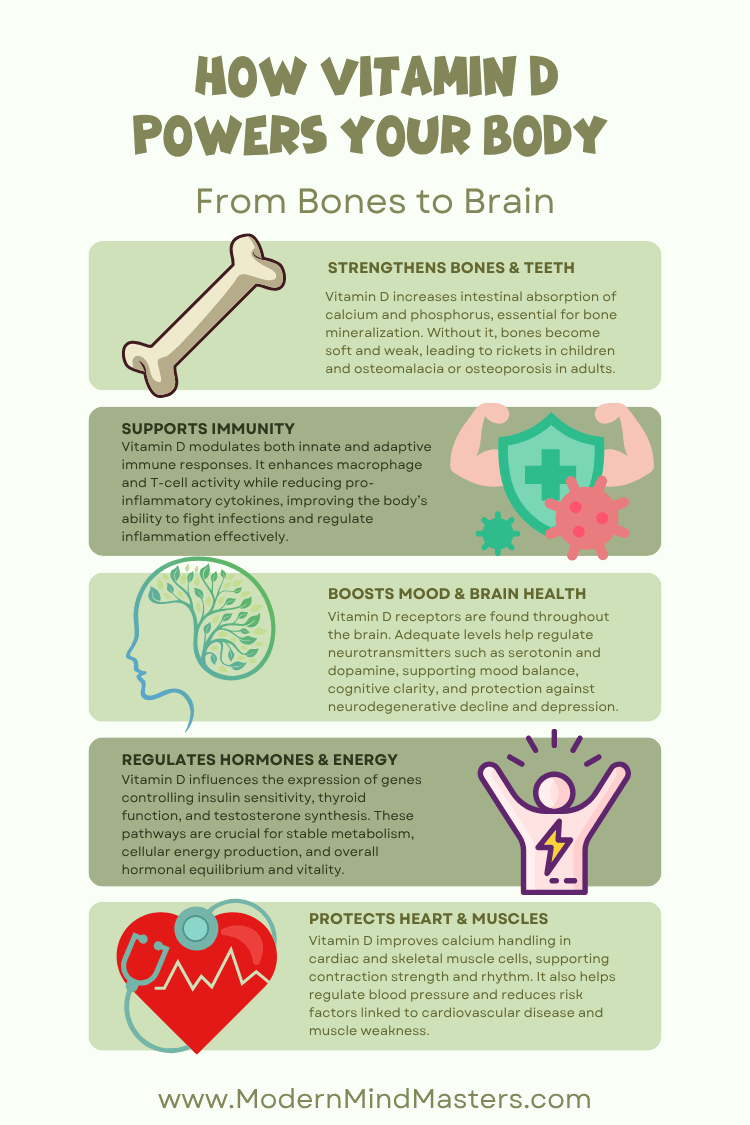
And because vitamin D deficiency is silent — it doesn’t sting like a sunburn or show up in a mirror — it’s easy to overlook. But low vitamin D levels are now linked with higher risks of autoimmune disease, depression, metabolic dysfunction, and even cancer. The irony is hard to miss: in trying to protect ourselves from the sun, we may be protecting ourselves from one of nature’s most essential nutrients.
This isn’t an argument for reckless sunbathing. It’s a reminder that context matters. Sunlight, like any natural exposure, can heal or harm depending on dose, duration, and skin type. The solution isn’t to block nature entirely, but to work with it intelligently — through short, regular, unprotected exposure balanced with real-food nutrition and, when needed, cautious supplementation.
If you’ve ever tried to research sunscreen safety for yourself, you’ve probably noticed the contradiction: half the studies find measurable absorption, hormonal effects, or ecological damage, while the other half insist there’s “no cause for concern.” Yet nearly all end the same way — with a reassuring line that “the benefits outweigh the risks.”
This isn’t a coincidence. Much of the sunscreen research that reaches the public isn’t conducted by independent scientists — it’s funded, reviewed, or published with ties to the very companies that sell these products.
Many of the world’s largest sunscreen brands — L’Oréal, Johnson & Johnson, Beiersdorf (Nivea), Procter & Gamble, and others — operate as both cosmetic manufacturers and pharmaceutical giants, with billions in shared interests across dermatology, skincare, and prescription medicine.

That financial overlap creates what’s politely called a conflict of interest — but in practice, it often shapes how “the science” is framed. When a study finds that certain UV filters enter the bloodstream or act on hormone receptors, the result is typically downplayed as “biologically insignificant.” It’s not that the data is false — it’s that the interpretation is softened.
This isn’t unique to sunscreen. The same pattern has played out for decades in pharmaceuticals, seed oils, and even the sugar industry — where legitimate findings of harm were minimized through selective reporting, industry-funded research, and carefully worded reassurances. The language of science was used not to deceive outright, but to maintain consumer confidence.
Sunscreen companies now walk a similar line. They acknowledge systemic absorption and environmental persistence — yet insist it poses no health concern. Meanwhile, regulatory agencies rely on the same data supplied by those companies to define what’s “safe.”
Science itself isn’t the problem — it’s the filter through which science reaches the public. When that filter is owned by the industry it’s meant to regulate, skepticism isn’t cynicism; it’s common sense.
Mineral or “physical” sunscreens — those made with zinc oxide or titanium dioxide — are often presented as the natural alternative to chemical UV filters. And in many ways, they are. These minerals don’t rely on hormone-active chemicals, they’re more photostable, and they sit on the skin’s surface rather than being absorbed into it.
That difference matters.
Together, they reflect, scatter, and absorb light to create a broad, relatively inert shield between skin and sunlight.
Surprisingly, physical barrier sunscreen can be just as effective as chemical, and will work as soon as they’re applied, as opposed to chemical barriers that require 15-30 minutes to absorb and get to work. Physical filters like zinc oxide also offer excellent broad-spectrum protection (both UVA and UVB), though they often top out around SPF 30–50 because of formulation limits.
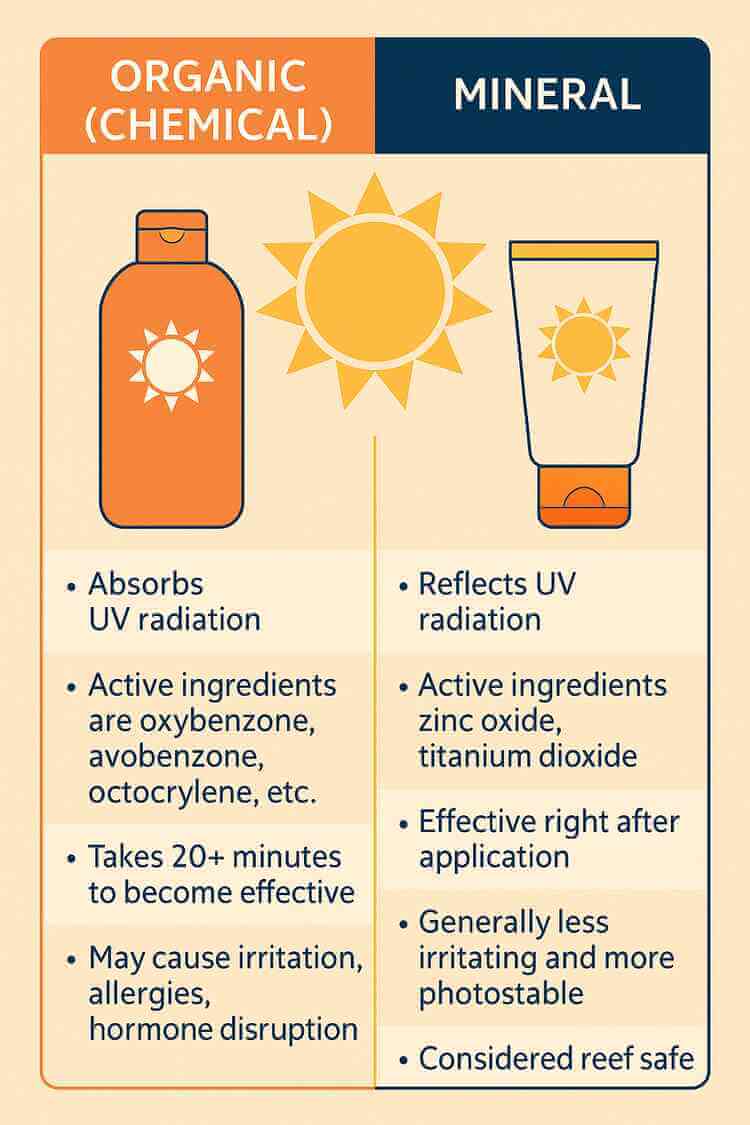
Unlike chemical sunscreens, mineral filters don’t appear to disrupt hormones, and studies consistently show minimal to no penetration through intact skin. For people with sensitive skin, children, or those concerned about systemic exposure, they’re by far the safer option. It’s no coincidence that zinc oxide is the same compound used in diaper creams and wound healing ointments — the skin recognizes it, tolerates it, and even benefits from it.
But “safer” doesn’t mean flawless. To make zinc and titanium dioxide more transparent and spreadable — avoiding the thick white film that turns most users away — manufacturers grind the minerals down to nanoparticle size. This improves texture but changes their behavior.
At the nanoscale, these particles become more chemically reactive and may generate free radicals under sunlight, especially when uncoated. Some research has shown oxidative stress and DNA damage in cultured cells at high concentrations, though whether this happens in real-world skin exposure remains unclear.
There are also environmental concerns. Even mineral sunscreens wash off in water, where zinc and titanium particles can accumulate in sediment and aquatic life. Nanoparticle zinc oxide, in particular, has been shown to induce oxidative stress in fish and invertebrates, suggesting that even “natural” filters have ecological consequences when used on a massive scale.
Simple tallow or oil-based moisturizers containing non-nano zinc oxide, such as the kind you can make yourself, can offer moderate UV protection — roughly equivalent to SPF 10–20 depending on concentration and film thickness. While this won’t replace high-SPF formulations for prolonged beach exposure, it’s a low-toxicity option for everyday sunlight, particularly when paired with sensible habits like limiting midday sun and wearing light clothing.
We’ve been taught to fear the sun — but the problem isn’t sunlight, it’s our lifestyle. Humans were never meant to spend 95% of their time indoors, only to shock their skin with vacation-long UV exposure once or twice a year.
That’s not natural biology; that’s modern imbalance. And no SPF number can make up for it.
Sun safety isn’t about living in shade — it’s about learning how to live with sunlight wisely.
Start with short, regular sessions — just a few minutes of unprotected sun on face, arms, and legs. The goal is to build tolerance naturally, not to burn. Midday sun (10 AM–2 PM) gives the strongest UVB for vitamin D production, but exposure should be brief and consistent. Think small, frequent doses rather than all-day marathons.
When extended exposure is unavoidable — at the beach, job sites, or long hikes — physical barriers are your safest line of defense:
Shade: use it strategically, not fearfully — the skin benefits from cycles of light and rest. Don’t go from zero exposure to eight hours at the beach. Begin with short exposures — 15 minutes of sunlight followed by 30 minutes of shade. Until your skin has built up tolerance, there’s no safe way to spend hours in direct sun without consequences.
If you do use sunscreen, choose mineral-based, non-nano zinc oxide formulas if you can. Avoid sprays and fragranced blends that may contain endocrine-active chemicals. Use them only when necessary, not as a daily moisturizer.
Homemade options — such as a tallow or oil base with non-nano zinc oxide — can offer mild, toxin-free protection for short everyday exposure. They won’t provide the same SPF as commercial formulas, but they also won’t burden your body or the environment.
Still, if the risk of burning is high, the short-term protection of a commercial sunscreen outweighs the theoretical risk of chemical absorption or environmental contamination. Severe burns are far more damaging — not only increasing long-term cancer risk but also accelerating skin aging and oxidative stress. The goal isn’t to avoid sunscreen entirely; it’s to use it consciously and sparingly, when your skin truly needs it.
Sun resilience isn’t just topical — it’s metabolic. A diet rich in antioxidants and fat-soluble vitamins (A, D, E, and K₂) improves the skin’s natural defenses against UV damage. Omega-3 fats, polyphenols (like those in green tea or berries), and minerals such as selenium help neutralize free radicals formed by sunlight. Generally, a good diet compared with regular exercise will provide you with a natural buff that will help take the edge off.
If you live far from the equator, UVB is weak or absent for much of the year. In those months, even the clearest skies won’t produce meaningful vitamin D. That’s when dietary sources — fatty fish, pastured egg yolks, liver, or supplements — become essential to maintain healthy levels.
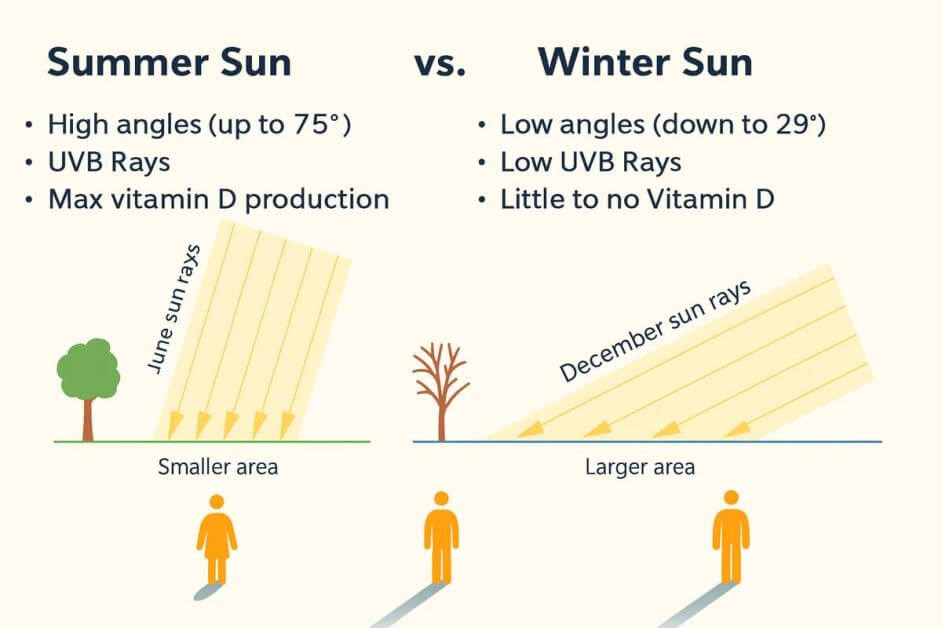
We’ve been taught to see sunlight as a threat — something to block and avoid at all costs. Yet the truth is more complex. Sunlight can both harm and heal. The issue isn’t the sun itself, but how modern life has distorted our relationship with it. We spend our days indoors under artificial light, then suddenly expose unadapted skin to hours of intense UV on weekends or vacations. That’s not what nature designed us for — and no sunscreen can fully correct that imbalance.
Chemical sunscreens may block UV, but they can also introduce compounds that penetrate the skin, disrupt hormones, and accumulate in the environment and even our food chain. Physical filters like zinc oxide are safer, but not perfect — especially in nanoparticle form. At the same time, overusing SPF products and avoiding natural sunlight entirely can rob us of one of the most fundamental nutrients for human health: vitamin D.
The solution isn’t fear or total avoidance — it’s balance. Gradual exposure, real food, natural protection, and respect for the body’s ability to adapt. Use sunscreen when you truly need it — during long or high-risk exposure — but don’t rely on it as a daily chemical shield. Let your skin relearn sunlight the way nature intended: progressively, intelligently, and with care.
Ultimately, living well with the sun isn’t about products or fear. It’s about rebuilding the lost rhythm between our biology and the natural world — one beam of light at a time.
Lorem ipsum dolor sit amet, consectetur adipiscing elit. Ut elit tellus, luctus nec ullamcorper mattis, pulvinar dapibus leo.
Lorem ipsum dolor sit amet, consectetur adipiscing elit. Ut elit tellus, luctus nec ullamcorper mattis, pulvinar dapibus leo.
Accordion Content

Boost focus and brainpower naturally. We review the top nootropics that support performance, memory, and mental clarity.

Oversleeping can leave you groggy and unmotivated. Learn simple, science-backed strategies to reset your sleep cycle and wake up refreshed.

The subconscious mind has long been surrounded by mystery, but cognitive sciences are unravelling the mystery.

What is consciousness? Explore how science explains awareness, decision-making, and the mysteries of the conscious mind.

ADHD can be managed with the right tools. Explore 5 treatments that actually work — from therapy to lifestyle strategies.

There are 3 rules for intermittent fasting for weight loss and health benefits that must be followed to extract benefits such as organ health and enhanced cellular repair.
You’ll Learn:
Effective Immediately: 5 Powerful Changes Now, To Improve Your Life Tomorrow.
Click the purple button and we’ll email you your free copy.